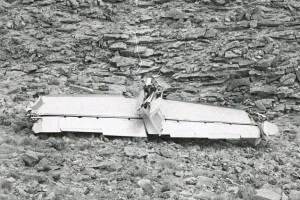Grand Canyon Collision Declared a National Historic Landmark
On Saturday, June 30, 1956, two planes collided, mid-air, over the desert skies of the Grand Canyon National Park. All 128 passengers on board both flights perished, making this collision the deadliest plane crash of its time. This was also the first commercial airline crash to result in over 100 deaths.
On April 2014, the site of the crash was declared a National Historic Landmark, making it the first landmark for an event that happened in the air. Due to the treacherous terrain at the location of the crash site, small parts of both planes still remain at the bottom of the Grand Canyon. The dangerous terrain made it impossible for rescue teams to recover all the pieces, and this is also the reason why the National Park Service isn’t disclosing the exact location of the crash site, because they don’t want people hiking there and it has been closed to the public since the 1950’s. So, What Went Wrong? On the morning of June 30, 1956, a TWA Lockheed L-1049 Super Constellation and a United Airlines DC-7 both left LAX. The United flight was headed to Chicago and the TWA flight was headed to Kansas City. Shortly after takeoff, the TWA pilot hit turbulence and requested to change altitude to 21,000 feet. His request was denied because the air traffic controller was aware that United was flying nearby. The pilot then asked for clearance to fly 1,000 feet on top of any weather in his path, operating under visual flight rules or VFR, his request was granted. At about 10:30AM, the flight paths of both aircrafts intersected over the Grand Canyon and collided at a closing angle of about 25 degrees. There were no alerts, and no warnings. Post-crash analysis determined that the United flight was banked to the right and pitched down at the time of impact, which suggests that one or possibly both of the United pilots saw the TWA aircraft, seconds before the impact and that evasive action was attempted. The planes hit the ground at 700 feet per second near the confluence of the Colorado and Little Colorado Rivers. Tragically, no bodies were recovered intact, and positive identification of the victims wasn’t possible. A mass funeral was held for the victims of the TWA flight at the Grand Canyon’s south rim. There’s also a burial site for the TWA passengers in Flagstaff, Arizona. National Historic Landmark With 128 fatalities, the Grand Canyon Collision was the deadliest commercial airline disaster of its time. This accident made headlines worldwide. As the story unfolded, people started learning about how outdated air traffic control was and how little was being done to modernize it. People were outraged, and the demands were being made for sweeping reforms for communication and safety for the airline industry. In 1957, a motion was introduced to boost air traffic control funding, to train air traffic controllers and modernize the system. Airports added radars, which proved very valuable for tracking aircrafts. Then a few years later, the Federal Aviation Agency was formed to oversee all American airspace. As procedures and air traffic controller facilities were modernized, air collisions started to gradually subside. This is why the site of the crash was declared a National Historic Landmark. The landmark status was more about the changes the crash brought about. So, even though this is one Historic Landmark that we can’t go visit with our families and take pictures of, it’s an important one because it made the friendly skies safer for everyone.


